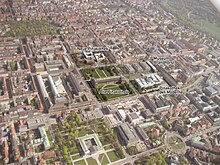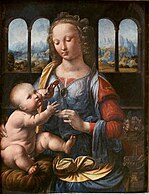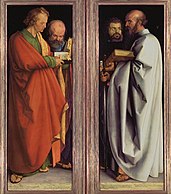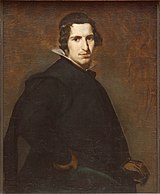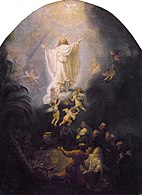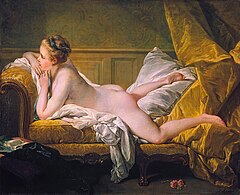Old Pinakothek
The Alte Pinakothek ( ) is an art museum opened in 1836 in the Kunstareal Munich ( “ Pinakothek ” , from Greek: pínax (genitive: pinakos) = “painting” and thēkē = “memory”, “storage place”). Among other things, it exhibits paintings by painters from the Middle Ages to the mid-18th century and is one of the most important picture galleries in the world. The holdings are part of the Bavarian State Painting Collections .
Opposite the Alte Pinakothek is the Neue Pinakothek with works from the late 18th, 19th and early 20th centuries. In addition to the Pinakothek der Moderne and the Brandhorst Museum with works from the 20th and 21st centuries as well as the Türkentor and other facilities, they together form the art area .
History of the collection
Founding by Duke Wilhelm IV.
The history of the art gallery in the Alte Pinakothek begins with the history paintings , the William IV. (R. 1508-1550) from 1528 were in order, including the famous " Battle of Alexander " by Albrecht Altdorfer . Maximilian I (reigned 1597–1651) ordered four large hunting scenes from Peter Paul Rubens in 1616 and also acquired works by Albrecht Dürer . In 1627, through gentle pressure on the Nuremberg city fathers, he received the work The Four Apostles , which the painter had given to his hometown. The elector let the city know that he would like to have the work and would take a negative decision as "a high despect". For his part, however, he suffered losses during the Swedish occupation in the Thirty Years War , as twenty-one paintings were brought to Stockholm from the Electoral Chamber of Wonder , of which only five could be brought back.
His grandson Maximilian II. Emanuel (r. 1679–1726) acquired numerous Dutch and Flemish paintings as governor of Spain in the Netherlands. In 1698 in Antwerp, for example, he bought 12 paintings by Peter Paul Rubens and 13 by Van Dyck from Gisbert van Colen , with Rubens' paintings coming from the artist's personal estate and therefore not intended for sale. Under Max Emanuel's successors, the purchases were largely stopped due to the tight budget.
The Palatinate Galleries
An equally careful collector of Dutch painting was Max Emanuel's cousin from the Palatinate , the Düsseldorf Elector Johann Wilhelm (r. 1690–1716), to whom the Düsseldorf gallery founded by his grandfather Wolfgang Wilhelm (r. 1614–1653) owed its most valuable treasures. Johann Wilhelm's art agents, who were active all over Europe, were given the task of spending the entire sum of money at their disposal on an excellent painting rather than on several mediocre ones. He received Raphael's famous “ Holy Family from the House of Canigiani ” as a bride present from his wife Anna Maria Luisa de 'Medici . 32 pictures from his Rubens collection alone are in the Alte Pinakothek today.
The Mannheim gallery was founded by Johann Wilhelm's brother, Elector Karl Philipp (ruled 1716–1742), and was significantly expanded by his successor Karl Theodor (ruled 1742–1799), who also had a weakness for Dutch painting. Among other things, he acquired Rembrandt van Rijn's “Holy Family”.
The Zweibrücker collection, which was brought to Mannheim and then to Munich in 1793 before the advancing French troops from Karlsberg Palace , emerged from the private collection of Christian von Mannlich (1741–1822), which Duke Karl August (r. 1775–1795) gave him . had bought; In addition to German, Flemish and Dutch pictures, it also contained works by younger French painters, including Chardin 's “ Rübenputzerin” and Boucher's “ Resting Girl ” (Marie-Louise O'Murphy). Karl August's brother, King Max I Joseph (r. 1799–1825), also collected paintings; among other things, he was the owner of one of the 37 surviving paintings by Jan Vermeer . However, the " woman with scales " was sold by the heirs in 1826 - before the successor Ludwig I had the Pinakothek built. Today the picture belongs to the National Gallery in Washington.
The union of the electoral gallery holdings
After the unification of Bavaria and the Palatinate, the Palatinate collections came to the Bavarian picture gallery, as they had to be brought to safety from the French revolutionary armies, such as the galleries of Mannheim (1798) and Zweibrücken (1799) and finally in 1806 with the assignment of the Duchy of Berg also has the rich Düsseldorf collection . On the other hand, the collection suffered new losses a short time later as a result of Napoléon Bonaparte's raid. Altdorfer's “Battle of Alexander” then hung in the emperor's bathroom. Only 27 of the numerous confiscated pictures were returned to Munich after his fall. Of the four large animal hunts that Maximilian I once ordered from Rubens, only the “hippopotamus hunt” is in Munich.
With the secularization in Bavaria , however, many pictures from the abolished monasteries came into royal possession at the same time, from which the collection of old German masters in particular benefited.
The foundation by King Ludwig I.
King Ludwig I of Bavaria (ruled 1825–1848) finally had numerous masterpieces bought up by art agents. He liked to collect old German pictures and works of the Italian Renaissance. There had been a gallery at the Hofgarten since the time of Elector Karl Theodor , but otherwise, due to the lack of space, the works of art in the royal collection were spread over various castles and could not be viewed by the people. Ludwig I not only systematized the collection activity, but at the beginning of the 1820s he felt obliged, based on the ideal of popular education, to make the art treasures accessible to the public. Therefore, he commissioned his house architect, architect Leo von Klenze , to build a museum building on the northern outskirts of Munich.
In 1827 Ludwig acquired the collection of the brothers Sulpiz and Melchior Boisserée with 216 old German and old Dutch masters; In 1828 the king also succeeded in purchasing the collection of Prince Wallerstein with 219 works of Upper German and Swabian painting. There were also purchases in Italy, e. B. Raphael's "Madonna with the Curtain". The princely collection thus reflects the taste of the respective collector personalities. This explains the strengths that are unattainable elsewhere, as well as the clear gaps in the stock of the Wittelsbacher Galerie.
The museum opened on October 16, 1836. In 1838 the first catalog of paintings was published by Johann Georg von Dillis , who was also responsible for the exhibition concept for the collection in the Alte Pinakothek. The opening of the Neue Pinakothek in 1853 the former was Pinakothek to Alte Pinakothek renamed.
After Ludwig I, the state only bought a few masterpieces. In 1852 even 1000 pictures were sold at the Schleissheim auction , including Dürer's “Anna Selbdritt” (now Metropolitan Museum, New York) and Grünewald's “Maria-Schnee-Tafel” (now Freiburg / Br.). It was not until 1875 when Franz von Reber (1834–1919, in office 1875–1909) was appointed director of the gallery that the Pinakothek received more attention. The time of the big acquisitions was over, however, even if he and his successor Hugo von Tschudi (1851–1911, in office 1909–1911) again acquired some outstanding pictures for the Pinakothek. For example, Leonardo da Vinci's “ Madonna with the Carnation ” or El Greco's “Undressing Christ” came to Munich. With Tschudi's successors Friedrich Dörnhöffer (in office 1912–1933) and Ernst Buchner (first term of office 1933–1945) the acquisition of further old German portraits was particularly successful, including those of Christoph Amberger , Martin Schaffner and Hans Baldung . In 1917, for example, Peter Bruegel the Elder's “land of milk and honey” was created . Ä. acquired.
After the Second World War
Shortly after the beginning of the Second World War, the pictures were relocated so that no losses occurred. It was not until the second half of the 20th century that gaps in the inventory were specifically closed, in particular through collecting activities and new acquisitions by banks that were connected to the Pinakothek and made the acquired treasures available to the Pinakothek on permanent loan. In particular, there were numerous purchases of paintings from the 18th century. From 1966, loans from the Bayerische Hypotheken- und Wechselbank were also acquired, including Lancret's “Bird Cage” and Boucher's “ Madame de Pompadour ”. In 1988, several Dürer factories were badly damaged by an acid attack by Hans-Joachim Bohlmann ; they were then restored over many years. In 1990 Dierick Bouts ' "Ecce agnus dei" was acquired.
building
At the laying of the foundation stone on April 7, 1826, Karl Schorn gave a speech, at the end of which everyone present shouted “Heil our King Ludwig !”. The building was completed in autumn 1836. Around 2,000 paintings were initially exhibited.
When it opened, the Alte Pinakothek was the largest museum building in the world and, thanks to the use of skylights and the practical accommodation of northern light cabinets, it was technically and conceptually well advanced for the time. The exterior of the Pinakothek already stands out clearly from the usual castle-like museum buildings of the early 19th century and is closely related to the function and structure of the building as a museum. The building became a model for several galleries in Rome, St. Petersburg and Kassel.
After being severely damaged, especially the central section, in 1943 and 1944, the Pinakothek was rebuilt by Hans Döllgast from 1952 to 1957 . He moved the main entrance to the north side, replaced the loggias on the south side with stairs, and converted the vestibule, the main staircase and the donor's hall on the east side into exhibition halls. Döllgast sealed a bomb hit in the south facade with a seal that differs from the Klenze building in terms of shape and color. The type of reconstruction, which makes the destruction visible, is usually viewed as an outstanding achievement in monument preservation , but is still controversial in public to this day. The art historian and Klenze biographer Adrian von Buttlar also criticizes the type of reconstruction:
“As simple and noble as Döllgast's post-war repair of the Munich Pinakothek appears in formal terms, its destructive intervention in the logical organism of Klenze's total work of art remains to this day by relocating the main entrance to the northern long side, replacing the loggias with new monumental stairs and a vestibule, converted the former staircase and donors' hall into exhibition rooms. "
Since autumn 2008, the halls on the upper floor of the Alte Pinakothek have been covered with a new wall covering with silk woven and dyed in Lyon (silk faille). The new color scheme in green and red goes back to the design of the halls, as it was prevalent since the time the Alte Pinakothek was built and well into the 20th century. Already for King Ludwig I of Bavaria and his architect Leo von Klenze , the use of wall covering alternating in red and green meant the continuation of a tradition that, with the exception of the old master paintings of the late 16th century, in many of the great picture galleries in Europe (Florence, London, Madrid, St. Petersburg, Paris, Vienna) and exists there to this day. The existing new coverings were financed from donations (foundations, private individuals, associations).
A general renovation took place from 1994 to 1998. In the years 2016 to 2018, the exterior of the Pinakothek was renovated step by step, with the affected exhibition halls being closed.
Exhibition space
The exhibition rooms are located on the ground floor and on the first floor. Most of the works are exhibited on the first floor. A distinction is made between rooms and cabinets ; In the halls, mainly important or large works of art are exhibited, while in the smaller cabinets on the side of the sculpture park, smaller and less important pictures are exhibited. Occupancy of the rooms on the ground floor and mezzanine floor:
- I to II and 1 to 4: changing exhibitions
- 16 to 23: Flemish painting , a.o. with works by Jan Brueghel the Elder .
Occupancy of the rooms on the upper floor, the main exhibition room:
- I, II a: Old Dutch painting , among others. with works by Joos van Cleve , Rogier van der Weyden , Hans Memling , Gerard David , Dieric Bouts d.Ä. and Lucas Cranach the Elder
- II, IIb: Old German painting , among others. with works by Hans Holbein the Elder , Matthias Grünewald , Albrecht Altdorfer , Albrecht Dürer and Lucas Cranach the Elder Ä.
- III: Cologne painting , among others. with works by Stefan Lochner , Master of the Bartholomew Altar , Master of the Life of Mary , Master of the Holy Kinship , Master of Saint Veronica , Master of the Aachen Altar
- IV: Italian painting of the Renaissance , a.o. with works by Fra Filippo Lippi , Sandro Botticelli , Pietro Perugino , Domenico Ghirlandaio , Leonardo da Vinci and Raffael
- V: Venetian painting , a.o. with works by Lorenzo Lotto , Tizian, Jacopo Tintoretto and Paolo Veronese
- VI: Flemish painting of the 17th century, a.o. with works by Frans Snyders , Jacob Jordaens , Anthonis van Dyck and Jan Fyt
- VII: Rubens Hall with works by Peter Paul Rubens and Frans Snyders
- VIII: Flemish painting, among others. with works by Peter Paul Rubens, Jan Fyt, Jacques d'Arthois and Pieter Boel
- IX: Dutch painting of the 17th century, among others. with works by Frans Hals , Pieter Lastman , Rembrandt and Philips de Koninck
- X: Italian baroque painting , inter alia. with works by Federico Barocci , Guido Reni , Luca Giordano , Giovanni Battista Tiepolo and Johann Liss
- XI: French painting of the 17th century, a.o. with works by Nicolas Poussin and Claude Lorrain
- XII: French painting of the 18th century, a.o. with works by François Boucher and Hubert Robert
- XIIa: French painting of the 18th century, a.o. with works by Nicolas Lancret , Maurice Quentin de La Tour and Claude Joseph Vernet
- XIIb: Italian painting of the 18th century, a.o. with works by Antonio Canaletto and Francesco Guardi
- XIII: Spanish painting , a.o. with works by El Greco , Francisco de Zurbarán y Salazar , Bartolomé Esteban Murillo and Diego Rodríguez de Silva y Velázquez
The collection
More than 700 paintings from the collection of several thousand pictures are permanently on display in the 19 halls and 47 cabinets; there are also temporary exhibitions. The following list contains some important works:
German painting from the 14th to 17th centuries
The Alte Pinakothek has the most extensive collection of old German paintings, including works by Stefan Lochner ("Adoration of the Child", 1445), Michael Pacher ("Church Father Altar", around 1480), Martin Schongauer ("The Holy Family", 1475/1480) , Albrecht Dürer (“ Self-Portrait in Pelzrock ” 1500) ( Paumgartner Altar , around 1503) (“ The Four Apostles ”, 1526), Hans Baldung Grien (“Margrave Christoph von Baden”, 1515), Albrecht Altdorfer (“ Laubwald mit dem Saint George ", around 1510), (" Susanna in the bath ", 1526), (" Danube landscape ", around 1525), (" The Battle of Alexander ", 1529), Lucas Cranach the Elder. Ä. ("Crucifixion of Christ", 1503), Hans Holbein the Elder. Ä. (Sebastian Altar, "Martyrium of St. Sebastian", 1516), Hans Burgkmair the Elder. Ä. (“Crucifixion Altar”, 1519), Matthias Grünewald (“The Saints Erasmus and Mauritius”, around 1520), Hans Holbein the Elder. J. ("Derich Born", around 1533), Barthel Beham ("Maria Jacobäa von Baden", 1533), Hans von Aachen ("Victory of Truth", 1598), Adam Elsheimer ("The Fire of Troy", 1600) , ("Flight to Egypt", 1609), Johann Liss ("Death of Cleopatra", around 1622) and Joachim von Sandrart ("November", from the series of monthly pictures, 1643)
Old Dutch painting from the 14th to 16th centuries
The collection of old Dutch paintings is one of the most exquisite in the world and contains masterpieces by Rogier van der Weyden (“ Columba Altar ”, around 1455), Dierick Bouts (“Ecce Agnus Dei”, approx. 1462), Hans Memling (“ The Seven Joys of Mary ”, 1480), Lucas van Leyden (“ Mary with the Child, St. Mary Magdalene and a Donor ”, 1522), Gerard David (“ The Adoration of the Magi ”, 1523), Adriaen Isenbrant (“ Rest auf der Flucht ”, around 1520), Jan Gossaert, called Mabuse (“ Danae ”, 1527), Marinus van Reymerswaele (“ A tax collector with his wife ”, 1538) and Hieronymus Bosch (“ Fragment of a Last Judgment ”, around 1515 ). The Alte Pinakothek also owns one of the three surviving replicas of the lost painting “The True Face of Christ” by Jan van Eyck (before 1500).
Dutch painting of the 17th century
Collected by many Wittelsbach princes, the collection of Dutch baroque painting forms a focus of the gallery with works by numerous masters such as Hendrick Goltzius (“Venus and Adonis”, 1614), Rembrandt van Rijn (“Self-Portrait”, 1629; “The Holy Family”, around 1633; “Descent from the Cross”, around 1633), Pieter Lastman (“Odysseus and Nausicaa”, 1619), Frans Hals (“Portrait of Willem van Heythuysen”, around 1625), Carel Fabritius (“Self-Portrait”, 1650), Ferdinand Bol (“The Head of the Amsterdamer Weingilde ”, 1659), Pieter Claesz (“ Still life with a tin can ”, around 1635), Adriaen van Ostade (“ Let out peasants in a tavern ”, approx. 1635), Salomon van Ruysdael (“ River landscape with ferry ”, around 1630), Gerard Terborch (“A boy fled his dog”, around 1655), Willem van de Velde the Elder . J. (“Calm Sea”, 1655), Karel Dujardin (“The Sick Goat”, around 1665), Jacob van Ruisdael (“Oaks on a Gießbach”, around 1675), Emanuel de Witte (“Family Portrait”, 1678) and Adriaen van der Werff (“Children playing under a Hercules sculpture”, 1687).
Flemish painting of the 16th and 17th centuries
The collection of Flemish masters occupies the central halls of the Pinakothek and includes, among others, major works by Pieter Brueghel the Elder. Ä. ("Schlaraffenland" 1566), Jan Brueghel d. Ä. ("Seaport with Christ's sermon", 1598), Peter Paul Rubens ("The Fall of the Damned", 1620/21) (" The Great Last Judgment ", 1617) ("The Little Last Judgment", around 1620) ("Löwenjagd ", 1621), Anthonis van Dyck (" Self-portrait ", around 1621) (" Susanna and the two old people ", around 1622), Adriaen Brouwer (" Peasants playing cards in a tavern ", around 1631), Jacob Jordaens (" The Satyr at the farmer ”, after 1620) and Jan Siberechts (“ Cattle pasture with sleeping woman ”, 1660).
The Rubens collection with 72 pictures is the world's largest in a permanent exhibition. The painting The Great Last Judgment is the largest painting in the museum.
Italian painting of the 13th to 18th centuries
The collection begins with works of the Italian Gothic, including Giotto's famous "Last Supper" (shortly after 1306), then all painting schools of the Italian Renaissance and Baroque are present with works by Masolino da Panicale ("Mary with Child", around 1435), among others. , Fra Angelico ("Entombment of Christ", around 1438), Fra Filippo Lippi ("Annunciation", around 1450), Leonardo da Vinci (" Madonna with the Carnation ", around 1473), Antonello da Messina ("Annunciata", 1474), Sandro Botticelli ("Lamentation of Christ", around 1490), Domenico Ghirlandaio ("Mary with the Child and Saint Dominic, John the Baptist and John the Evangelist", around 1494), Luca Signorelli ("Mary with the Child" , 1495/1498), Lorenzo Lotto ("The Mystical Marriage of St. Catherine", around 1505), Raffael ("The Holy Family from the House of Canigiani", around 1505), (" Madonna Tempi ", 1507), ( "Madonna with the Curtain", 1514), Titian ("The Vanity of the World", around 1515); ("The Crowning of Thorns", around 1570), Jacopo Tintoretto ("Vulkan surprises Venus and Mars", around 1555), Paolo Veronese ("Cupid with two dogs", 1575/1580), Federico Barocci ("Christ and Magdalena", 1590 ), Bartolomeo Manfredi ("Christ crowned with thorns", around 1609), Orazio Gentileschi ("Martha rebukes her sister Maria", around 1620), Carlo Saraceni ("Vision of St. Francis", around 1620), Guido Reni ("The Ascension Maria "1631/42), Luca Giordano (" A Cynical Philosopher ", around 1660), Canaletto (" Piazetta in Venice ", around 1730), Giovanni Battista Tiepolo (" The Adoration of the Magi ", 1753) and Francesco Guardi (" Regatta on the Canale della Giudecca ”, around 1784).
French painting of the 17th and 18th centuries
Despite the close ties between the Wittelsbach family and France, the collection of French paintings has remained the second smallest collection in the Alte Pinakothek, with works by Nicolas Poussin ("Midas and Bacchus", around 1627), Sébastien Bourdon ("A Roman lime kiln", around 1637) , Claude Lorrain ("Seaport with the Rising Sun", 1674), Nicolas Lancret ("The Bird Cage", 1735), Jean Siméon Chardin ("Beet Cleaner", around 1740), Jean Marc Nattier ("The Marquise de Baglion as Flora", 1746), Maurice-Quentin de la Tour (“Mademoiselle Ferrand meditates on Newton”, 1752), Jean-Étienne Liotard (“Breakfast”, around 1754), Claude Joseph Vernet (“Oriental seaport at sunrise”, 1755), François Boucher (" Madame de Pompadour ", 1756), Jean-Honoré Fragonard ("Girl with a dog", around 1770) and others.
Spanish painting of the 16th and 17th centuries
Although the “Spanish Painting” section is the smallest in the Alte Pinakothek, all of the great masters are represented, including El Greco (“The Undressing of Christ”, around 1595), De la Cruz (“Infanta Isabella Clara Eugenia of Spain”, 1599) and Velázquez ("Young Spanish nobleman", around 1625), Jusepe de Ribera ("St. Bartholomew", around 1635), Zurbarán ("The Entombment of St. Catherine of Alexandria on Mount Sinai", around 1636), Alonso Cano (" Our Lady appears to St. Anthony ", around 1645), Murillo (" Grape and Melon Eaters ", 1645) (" Beggar Boys Playing Dice ", around 1670) and Claudio Coello (" St. Peter of Alcantara walks across the Quandiana River ") , around 1690). Francisco de Goya's pictures were incorporated into the Neue Pinakothek .
- Sample images
Albrecht Dürer : "Oswolt Krel"
Albrecht Dürer: " The Four Apostles "
Albrecht Dürer: " Self-Portrait "
Raffael : " Madonna Tempi "
El Greco : "Undressing Christ"
Diego Velásquez : "Young Spanish nobleman"
Rembrandt van Rijn : "The Ascension"
François Boucher : "Resting Girl"
Bearers and sponsors
The Alte Pinakothek is part of the Bayerische Staatsgemäldesammlungen and reports to its director. The office has been held by Bernhard Maaz since April 1, 2015 . In addition to the state of Bavaria, the main sponsor of the museum is the Pinakotheks-Verein (Association for the Promotion of the Old and New Pinakothek in Munich eV). Its board of trustees is Franz Herzog von Bayern , the patrons are the current German Federal President , the Bavarian Prime Minister and the head of the House of Wittelsbach . The chairwoman of the association is Elisabeth Princess zu Sayn-Wittgenstein -Berleburg, her deputies are Gerd Amtstätter and Oliver Kasparek. The aim of the association's statutes is primarily to purchase additional works of art for the Munich Pinakotheken .
Special exhibitions
(incomplete) The Alte Pinakothek shows special exhibitions in loose succession, the concept of which is largely based on the permanent exhibition. Previous special exhibitions have included:
- Rembrandt: "The Sacrifice of Isaac" - On the painting by Rembrandt van Rijn with the motif of the Sacrifice of Isaac (March 24 to June 27, 2004)
- Flemish Baroque for Neuburg Castle - To the paintings in the Residenzschloss in Neuburg an der Donau (June 23 to September 5, 2004)
- From new stars: Adam Elsheimer's “Flight to Egypt” - on Adam Elsheimer 's work of the same name. Curator: Marcus Dekiert (December 17, 2005 to February 26, 2006)
- Leonardo . The " Madonna with the Carnation " (September 14th to December 4th, 2006)
- Parmigianino and his circle - works by Francesco Mazzola called Parmigianino, the circle of artists around him and his successor Girolamo Mazzola Bedoli (November 22, 2007 to February 24, 2008)
- “ Frame art .” In search of traces in the Alte Pinakothek - also included part of the frame collection (January 28 to April 18, 2010)
- Arnulf Rainer - The painter. Retrospective on the artist's 80th birthday in the Alte Pinakothek ; Modern Art Collection (June 10 to September 19, 2010)
- Vermeer in Munich - King Max I Joseph of Bavaria as a collector of old masters (March 17, 2011 to June 19, 2011)
- " Cranach in Bavaria", April 14th - July 17th 2011
- "Up and down - Altdorfer, Cranach and Dürer on the trail", 7 July to 18 September 2011
- Perugino - Raphael's master, October 13, 2011 to January 15, 2012
- "Brueghel" - painting by Jan Brueghel d.Ä. , March 22, 2013 to June 16, 2013
- “The Old Testament - Stories and Creations”, July 18 to October 20, 2013
- “Canaletto. Bernardo Bellotto paints Europe “2014.
- Florence and its painters: From Giotto to Leonardo da Vinci , October 18, 2018 to February 3, 2019
- " Van Dyck - Fame and Rivalry in the Flemish Baroque ", October 25, 2019 to February 2, 2020
Movies
- Museum check with Markus Brock : Alte und Neue Pinakothek, Munich. 30 min. First broadcast: January 15, 2012.
literature
- Reinhold Baumstark (editor): Alte Pinakothek. The masterpieces . DuMont Buchverlag, Cologne 2006, ISBN 978-3-8321-7592-4 .
- Rüdiger an der Heiden: The Alte Pinakothek. Collection history, construction and pictures . Hirmer , Munich 1999, ISBN 978-3-7774-7840-1 .
- Martin Schawe: Alte Pinakothek Munich , Prestel Museum Guide series , 143 pages, Munich, Prestel , Munich 1999, ISBN 978-3-7913-2114-1 .
- Bayerische Staatsgemäldesammlungen (Ed.): Old German and Old Dutch painting. Old Pinakothek . Texts by Martin Schawe. Hatje Cantz, Stuttgart 2007, ISBN 3-7757-1842-7
- Bayerische Staatsgemäldesammlungen (Ed.): Dutch and German painting of the 17th century. Old Pinakothek . Foreword by Reinhold Baumstark, texts by Markus Dekiert. Hatje Cantz, Stuttgart 2006, ISBN 3-7757-1844-3 .
- Bavarian State Painting Collections (Ed.): Italian Painting. Old Pinakothek . Foreword by Reinhald Baumstark, texts by Cornelia Syre. Hatje Cantz, Stuttgart 2007, ISBN 978-3-7757-1840-0 .
- Bayerische Staatsgemäldesammlungen (Ed.): Flemish Painting. Old Pinakothek. Foreword by Reinhold Baumstark, texts by Mirjam Neumeister. Hatje Cantz, Stuttgart 2008, ISBN 978-3-7757-1841-7 .
- Bayerische Staatsgemäldesammlungen (Ed.): French and Spanish painting. Old Pinakothek . Foreword by Reinhold Baumstark, texts by Helge Siefert. Hatje Cantz, Stuttgart 2009, ISBN 978-3-7757-1839-4 .
- Martin Schawe: Old German and Old Dutch Painting, Alte Pinakothek, 2nd revised edition, Hantje Cantz Verlag, Ostfildern, 2014. ISBN 978-3-7757-3904-7
Web links
- Internet presence of the Alte Pinakothek
- Wunderkammer für das Volk - 175 Years Old Pinakothek Munich ( Memento from February 1, 2012 in the Internet Archive ) broadcast of the Bavarian Radio from 2011 (MP3, approx. 55 min.)
- Kulturportal bavarikon - paintings from the Alte Pinakothek, high resolution
- Over 3,000 works of art from the Alte Pinakothek in the online collection of the Bayerische Staatsgemäldesammlungen (images with Creative Commons licenses)
- Open Access Bayerische Staatsgemäldesammlungen - inventory books and inventory catalogs of the Alte Pinakothek as PDF digital copies
Individual evidence
- ↑ Pinakothek - Wiktionary. Retrieved November 15, 2017 .
- ^ Natural History and History Painting in Rubens' Animals . Archived from the original on November 19, 2016. Retrieved January 2, 2017.
- ↑ Vermeer in Muenchen kunstundfilm.de
- ^ The opening of the Pinakothek in Munich. In: Carinthia. A weekly paper for use and pleasure / Carinthia / Carinthia. Constitutional sheet for time interests , November 12, 1836, p. 187 (online at ANNO ).
- ↑ www.pinakothek.de History. Accessed January 1, 2018.
- ↑ Germany. In: Oesterreichischer Beobachter , April 14, 1826, p. 3 (online at ANNO ).
- ↑ Johann Michael von Söltl: Munich with its surroundings , page 225. Munich 1854 , queried on January 2, 2011
- ↑ From our time. In: The Austrian viewer. For art, science and intellectual life / sheets for intellectual activity, scientific discussions and useful studies / special supplement / Viennese viewers / sheets for intellectual activity and scientific discussions / special supplement / viewers / special supplement / Viennese viewers. Magazine for educated / Austrian viewers. Political-literary weekly newspaper / The Austrian Viewer. Political-literary weekly paper , October 21, 1836, p. 1275 (online at ANNO ).
- ↑ www.muenchen.de Sights: Alte Pinakothek. Accessed January 30, 2013.
- ^ Adrian von Buttlar: Leo von Klenze - life, work, vision. CH Beck, Munich 1999, page 265
- ↑ www.pinakothek.de - Collection - Tour , accessed on January 2, 2018
- ↑ Bavarian State Ministry for Science and Art : State Museums and Collections in Bavaria ( Memento from April 24, 2012 in the Internet Archive ) , last accessed on August 10, 2012.
- ↑ www.pinakothek.de - Förderer und Partner , accessed on January 2, 2018.
- ↑ www.pinakothek.de - exhibition archive , accessed on January 2, 2018.
- ↑ www.pinakothek.de - Exhibition archive: Rembrandt: "The Sacrifice of Isaac" ( Memento from June 3, 2006 in the Internet Archive )
- ↑ www.ganz-muenchen.de: “Flämischer Barock für Schloß Neuburg” , accessed on January 1, 2018.
- ^ Lit .: Adam Elsheimer, Reinhold Baumstark and Marcus Dekiert: Von Neuen Sternen. Adam Elsheimer's “Flight to Egypt” , DuMont-Buchverlag, 2005, 226 pages, ISBN 978-3-8321-7583-2 .
- ↑ books.google.de - Catalog: Leonardo. “The Madonna with the Carnation” , accessed on January 1, 2018.
- ↑ www.pinakothek.de - Exhibition archive: Parmigianino and his circle ( Memento from July 6, 2009 in the Internet Archive )
- ↑ www.lifepr.de Exhibition Archive - Frame Art , accessed on January 10, 2018.
- ↑ www.muenchen.bayern.de Exhibition, accessed on January 1, 2018.
- ↑ www.pinakothek.de Exhibition archive : “Vermeer in Munich”, accessed on June 25, 2011.
- ↑ www.pinakothek.de Exhibition review . Accessed November 19, 2013.
- ^ Museum check: Old and New Pinakothek, Munich. In: Fernsehserien.de. Retrieved November 12, 2020 .
Coordinates: 48 ° 8 ′ 54 ″ N , 11 ° 34 ′ 12 ″ E

